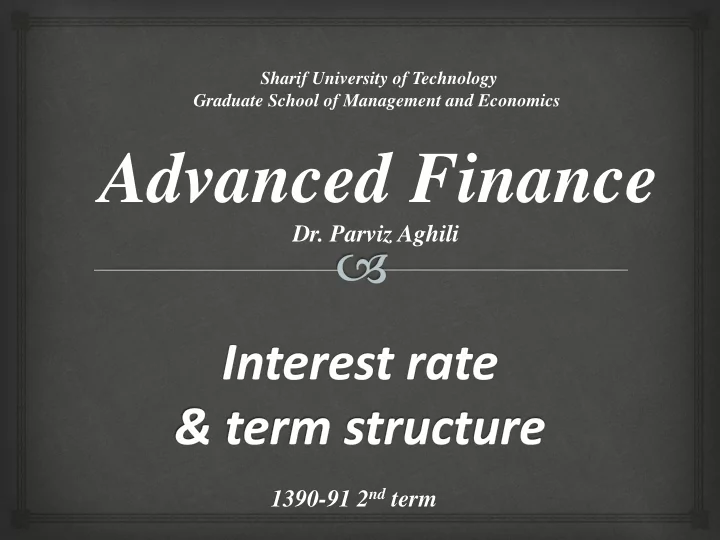

Sharif University of Technology Graduate School of Management and Economics Advanced Finance Dr. Parviz Aghili 1390-91 2 nd term
Interest rate Nominal interest rate: rate at which money invested grows. The nominal interest rate is the amount, in money terms, of interest payable. Real interest rate: measures the purchasing power of interest receipts, so it takes inflation into account. 2
Interest rate (cont.) The following model describes the relationship between real and nominal interest rate: 𝑗 𝑜 = 𝑗 𝑠 + 𝐽 + 𝜏 Where: 𝑗 𝑜 =nominal interest rate 𝑗 𝑠 =real interest rate 𝐽 =inflation rate 𝜏 =risk premium *Normally 𝑗 𝑠 is between 3- 5% (In Iran it’s about 4%). 3
Term Structure The term structure is the relation between the yield and the time to maturity. It’s also known as yield curve . The yield curve may take various shapes such as: ascending, descending, flat and humped. 4
Normal (ascending) yield curve The normal shape for yield curve is upward sloping. the longer the maturity, the higher the yield, with diminishing marginal increases. 5
Normal yield curve (cont.) There are two common explanations for upward sloping yield curves. First: it may be that the market is anticipating a rise in the risk-free rate. If investors hold off investing now, they may receive a better rate in the future. Second: longer maturities entail greater risks for the investor. A risk premium is needed by the market since at longer durations there is more uncertainty. 6
Inverted yield curve An inverted yield curve occurs when long-term yields fall below short- term yields. This happens under unusual circumstances (e.g. a rise in inflation caused by an external factor) 7
Humped yield curve A humped curve results when medium-term yields are higher than those of the short-term and long-term. This may happen when market anticipates a rise in short-term yields in near future. 8
Flat yield curve A flat yield curve is observed when all maturities have similar yields. A flat curve sends signals of uncertainty in the economy. It can revert to a normal curve or could later result into an inverted curve. 9
Theories explaining the yield curve 1) Market expectations hypothesis: This hypothesis suggests that the shape of the yield curve depends on market participants' expectations of future interest rates. Where 𝑗 𝑚𝑢 and 𝑗 𝑡𝑢 successively represent interest rates for long-term and short-term periods. 10
Theories explaining the yield curve (cont.) 2) Liquidity Preference Theory This Theory asserts that long-term interest rates not only reflect investors’ assumptions about future interest rates but also include a premium for holding long-term bonds. Where rp n is the risk premium associated with an n year bond. 11
Theories explaining the yield curve (cont.) 3) Market segmentation theory In this theory, financial instruments of different terms are not substitutable. As a result, the supply and demand for the money market and capital market instruments is determined independently. This theory fails to explain the observed fact that yields tend to move together (i.e., upward and downward shifts in the curve). 12
U.S. interest rates during 1978-1984 13
Monetary policy and inflation A rise in short-term rates will lead to an inverted yield curve. It can be used as a contractionary monetary policy for dealing with inflation (as in case of U.S.). 14
Monetary policy and inflation (cont.) But increasing short-term and long term rates will lead to an upward shift of the whole curve. This policy -as being used in Iran- will stabilize inflation in the economy. 15
Recommend
More recommend